5.11.2023
Zoomable JWST Image Brings Far-Distant Galaxies to Your Fingertips
The James Webb Space Telescope is gazing across the universe to find galaxies close to the “cosmic dawn”—and you can explore them from the palm of your hand
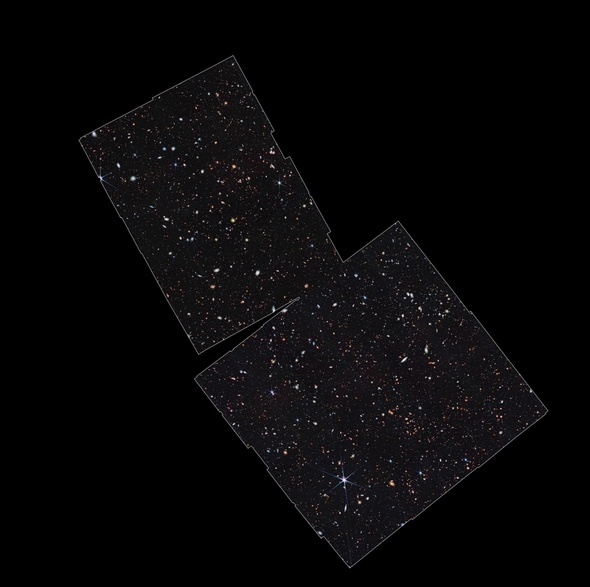
This image from the James Webb Space Telescope (JWST) highlights a celestial region being intensively studied by the JWST Advanced Deep Extragalactic Survey (JADES). Much of this image overlaps with the JADES Origins Field, one of JWST's deepest looks into the early cosmos. Credit: NASA, ESA, CSA, M. Zamani (ESA/Webb)
What was the universe like at the cosmic dawn?
That poetic phrase is what astronomers call the time just a few hundred million years after the big bang when the very first stars switched on, flooding the cosmos with light.
To see this era, we’d need a time machine, and, astoundingly, we have one. We have many, actually: telescopes. Light travels very quickly—at the speed of a billion kilometers per hour!—but still, galaxies are so far away that it takes their light millions or even billions of years to reach us. The farther they are from Earth, the longer it takes for their light to reach us. So, in a sense, when we glimpse their far-flung photons, we see backward through time to observe these ancient galaxies as they were long ago.
The light from galaxies at the cosmic dawn has been traveling for more than 13 billion years. Attenuated across the vast distance—which has grown all the while as the universe expands—that light arrives to us not only exceedingly faint but also very redshifted, meaning that its once-optical wavelengths have stretched out into the infrared portion of the electromagnetic spectrum. Gathering enough of it to do cutting-edge science—let alone make pretty pictures—requires a huge telescope that is keenly sensitive to any infrared glow.
This is precisely why astronomers built the James Webb Space Telescope (JWST). With its huge 6.5-meter segmented mirror and multiple infrared-attuned instruments, it can see galaxies as they were not too long after the first stars were born and possibly maybe even all the way back to the cosmic dawn.
To push the limits of JWST’s capabilities, astronomers designed a special observing program called the JWST Advanced Deep Extragalactic Survey, or JADES. It looks at a very small area in the sky for long periods of time to get “deep-field” images of the vastly remote objects across the universe from Earth. And now researchers are leveraging the success of that project in JWST’s first year in space. A carefully selected subsection of that area is now the target of the JADES Origins Field, which in the telescope’s current sophomore year will push the observations even deeper into the universe, hopefully taking the measure of galaxies closer to the cosmic dawn.
The program has already returned riches from those almost unfathomable depths. And you can see and explore them for yourself, all from the cozy comfort of your desk (or anywhere else you might use your smartphone)! A mosaic of the observations so far is available online. When first displayed, it looks like a patchy, irregular black field dotted with smudges. But if you zoom in and in and in, you’ll find that the brightest objects are glorious galaxies: many of them are recognizable as spirals, but most, by far, are more irregular in shape. A similar galactic bestiary populates the magnificent Hubble Deep Fields, earlier images from the Hubble Space Telescope that revealed smaller “fragments” of galaxies apparently in the act of merging to form the larger galaxies we see today.
A scattering of stars in our own galaxy can be distinguished here and there in the JADES field. Each of them stands out from objects far more distant via its very sharp, pointlike appearance, as well as the presence of diffraction spikes—three pairs of lines that radiate away from a star’s center and are caused by the bending of light around the hexagonal one-meter mirror segments that make up JWST’s primary mirror. Close inspection also shows a faint horizontal line bisecting each Milky Way star, which is caused by light bending around a support strut of the telescope’s secondary mirror.
If you look very carefully, however, you’ll even find some far-distant fuzzy objects with very bright cores that also display diffraction spikes, such as object 169604. These objects are likely active galaxies, each harboring a central supermassive black hole that is eagerly—and sloppily—eating huge amounts of gas and dust. This material heats up viciously and blasts out radiation as it spirals to its doom at a hefty fraction of the speed of light before finally vanishing across the black hole’s event horizon—the ultimate point of no return.
In fact, one hope for the JADES Origins Field is to find distant galaxies where these gargantuan black holes are just getting their start; one of the biggest mysteries in cosmology is how these black holes grow to be behemoths with a billion times the sun’s mass in less than a billion years.
Many of the astronomical objects in this mosaic can be identified by their color, that is, how bright they appear at different wavelengths. The Near-Infrared Camera, JWST’s workhorse instrument, has filters that select for different wavelengths, several of which are used by JADES. You can switch the display between filters by clicking the top “layers” icon in the upper right corner of the mosaic’s webpage to see how appearances change when you change what flavor of light is observed. The distribution of light across colors is called the spectral energy distribution, or SED, and the bottom “layers” icon has an option to show this. Astronomers use the SED to determine what kind of object they’re seeing and, for galaxies, the approximate distance.
Poking around the image I found plenty of odd objects to ogle. For example, object 196582 is clearly some sort of galaxy that is likely more than seven billion light-years away. But it has a fuzzy, oval-shaped arc stretching above it. Sometimes the gravity of a massive galaxy can bend the light from more distant background galaxies, warping them into unusual shapes in a process called gravitational lensing. But those arcs are usually sharply defined and thin, and this is clearly not. Another possibility is a galactic disruption: galaxies sometimes pass close to each other as they fly through space, distorting and twisting from their gravitational interplay and pulling out streamers of stars like cosmic strands of stretched taffy. If one galaxy is much smaller than the other, it can be totally torn apart. That could be what we’re seeing here.
There are also less extreme encounters. Objects 171522 and 171523 are a pair of interacting galaxies that seem to be roughly equal in size, and each is distorting the other. After enough time, it’s possible this duo will physically merge, becoming a single, larger galaxy. Many such examples of galaxy collisions can be found in the mosaic, adding to our understanding of how galaxies interacted and grew in the universe’s early days.
The most amazing thing about this image probably isn’t any specific object but rather the sheer number of objects that JWST captures in the entire JADES field. Astronomers have counted on the order of 100,000 galaxies there, yet it covers only a tiny fraction of the sky, appearing about the same size as would a piece of very fine gravel on your fingertip held out at arm’s length. Extrapolated across the entire sky, this means that the heavens above hold hundreds of billions of galaxies, which is comparable to previous estimates; the depths of the JADES Origins Field will reveal greater numbers of them still, giving us more to study and more precise measurements of them as well.
It’s a powerful reinforcement of a staggering fact: the universe is positively brimming with galaxies. Our Milky Way is just one of them, and were we to look at it with JWST from 10 billion light-years away, it would be just another among the teeming throng, like those in the JADES field. It’s humbling, certainly, but for me, it’s also a source of joy and even pride: we can grasp this fact. Through science, driven by our ever-hungry curiosity and ever more powerful technology, we can know our true place in the universe—and even bring its most distant depths to our fingertips.
But don’t take my word for it. Find out for yourself by diving into the JADES treasure trove, teeming with galaxies at the cusp of cosmic dawn.
Quelle: SCIENTIFIC AMERICAN
----
Update: 10.11.2023
.
NASA’s Webb Findings Support Long-Proposed Process of Planet Formation
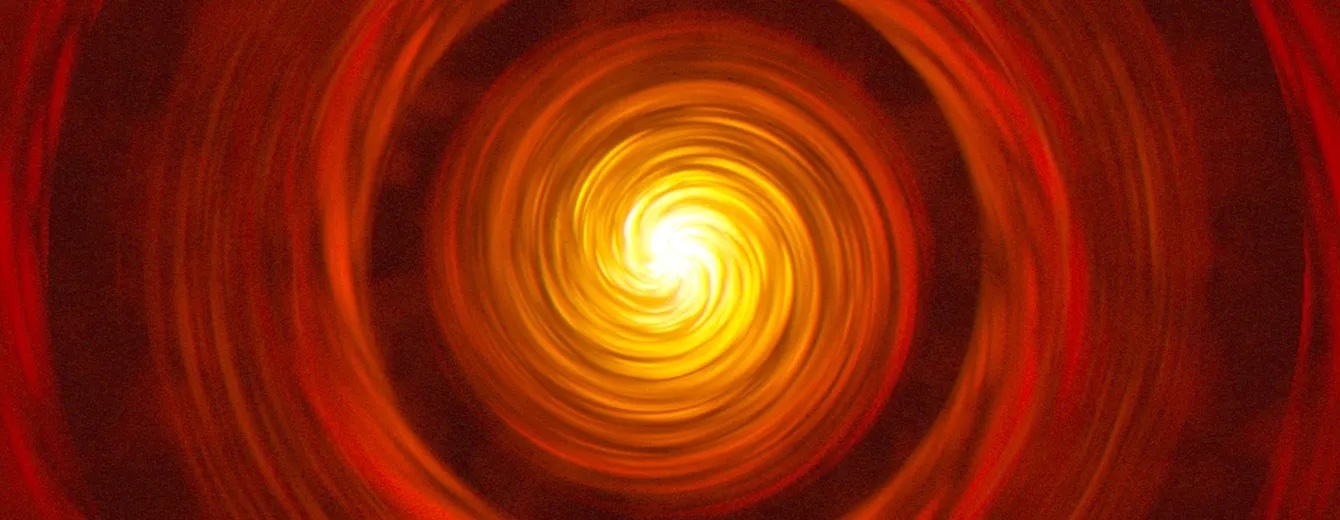
Scientists using NASA’s James Webb Space Telescope just made a breakthrough discovery in revealing how planets are made. By observing water vapor in protoplanetary disks, Webb confirmed a physical process involving the drifting of ice-coated solids from the outer regions of the disk into the rocky-planet zone.
Theories have long proposed that icy pebbles forming in the cold, outer regions of protoplanetary disks — the same area where comets originate in our solar system — should be the fundamental seeds of planet formation. The main requirement of these theories is that pebbles should drift inward toward the star due to friction in the gaseous disk, delivering both solids and water to planets.
A fundamental prediction of this theory is that as icy pebbles enter into the warmer region within the “snowline” — where ice transitions to vapor — they should release large amounts of cold water vapor. This is exactly what Webb observed.
“Webb finally revealed the connection between water vapor in the inner disk and the drift of icy pebbles from the outer disk,” said principal investigator Andrea Banzatti of Texas State University, San Marcos, Texas. “This finding opens up exciting prospects for studying rocky planet formation with Webb!”
“In the past, we had this very static picture of planet formation, almost like there were these isolated zones that planets formed out of,” explained team member Colette Salyk of Vassar College in Poughkeepsie, New York. “Now we actually have evidence that these zones can interact with each other. It’s also something that is proposed to have happened in our solar system.”
Image: Planet-forming Disks
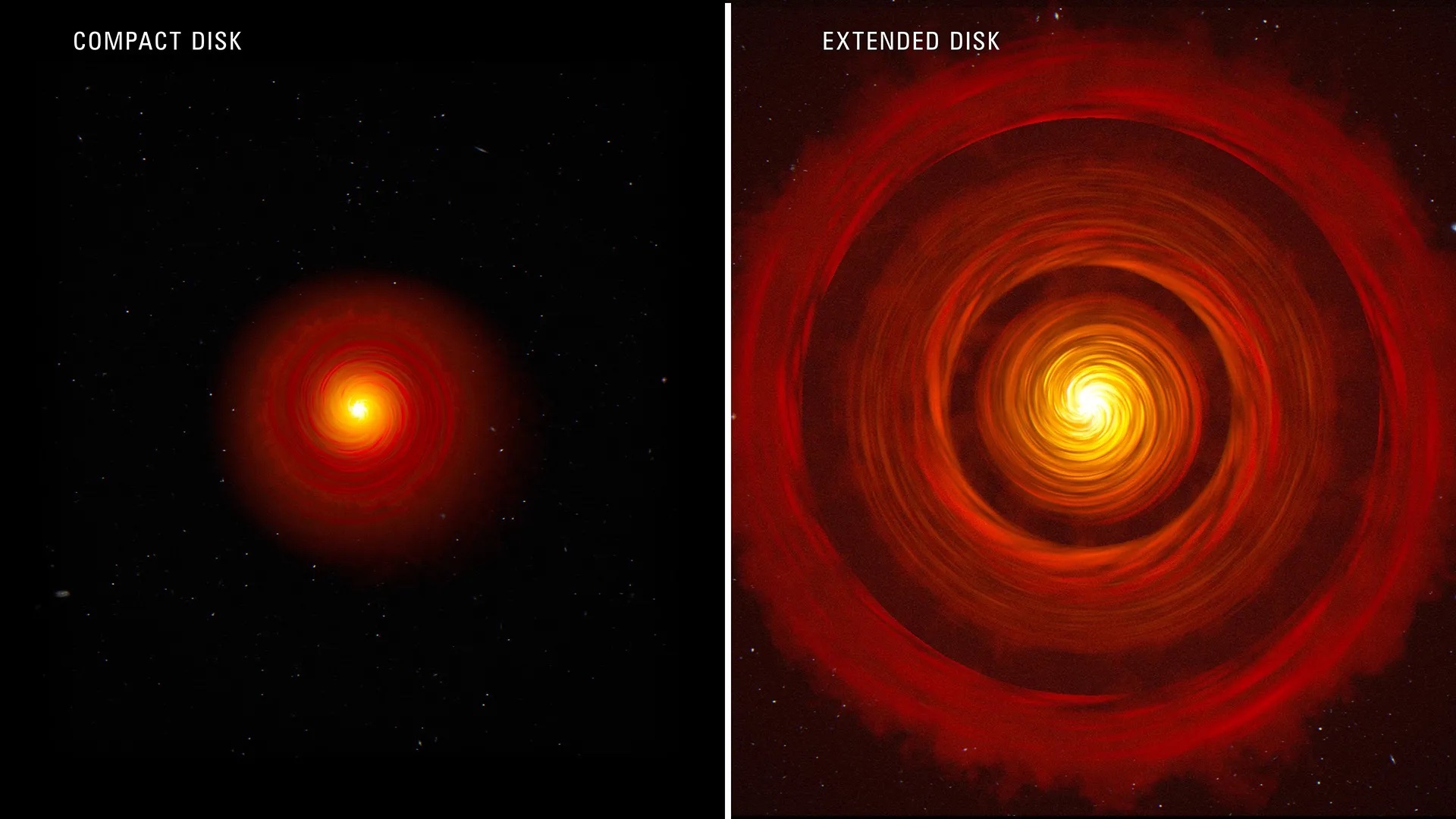
Harnessing the Power of Webb
The researchers used Webb’s MIRI (the Mid-Infrared Instrument) to study four disks — two compact and two extended — around Sun-like stars. All four of these stars are estimated to be between 2 and 3 million years old, just newborns in cosmic time.
The two compact disks are expected to experience efficient pebble drift, delivering pebbles to well within a distance equivalent to Neptune’s orbit. In contrast, the extended disks are expected to have their pebbles retained in multiple rings as far out as six times the orbit of Neptune.
The Webb observations were designed to determine whether compact disks have a higher water abundance in their inner, rocky planet region, as expected if pebble drift is more efficient and is delivering lots of solid mass and water to inner planets. The team chose to use MIRI’s MRS (the Medium-Resolution Spectrometer) because it is sensitive to water vapor in disks.
The results confirmed expectations by revealing excess cool water in the compact disks, compared with the large disks.
Image: Water Abundance
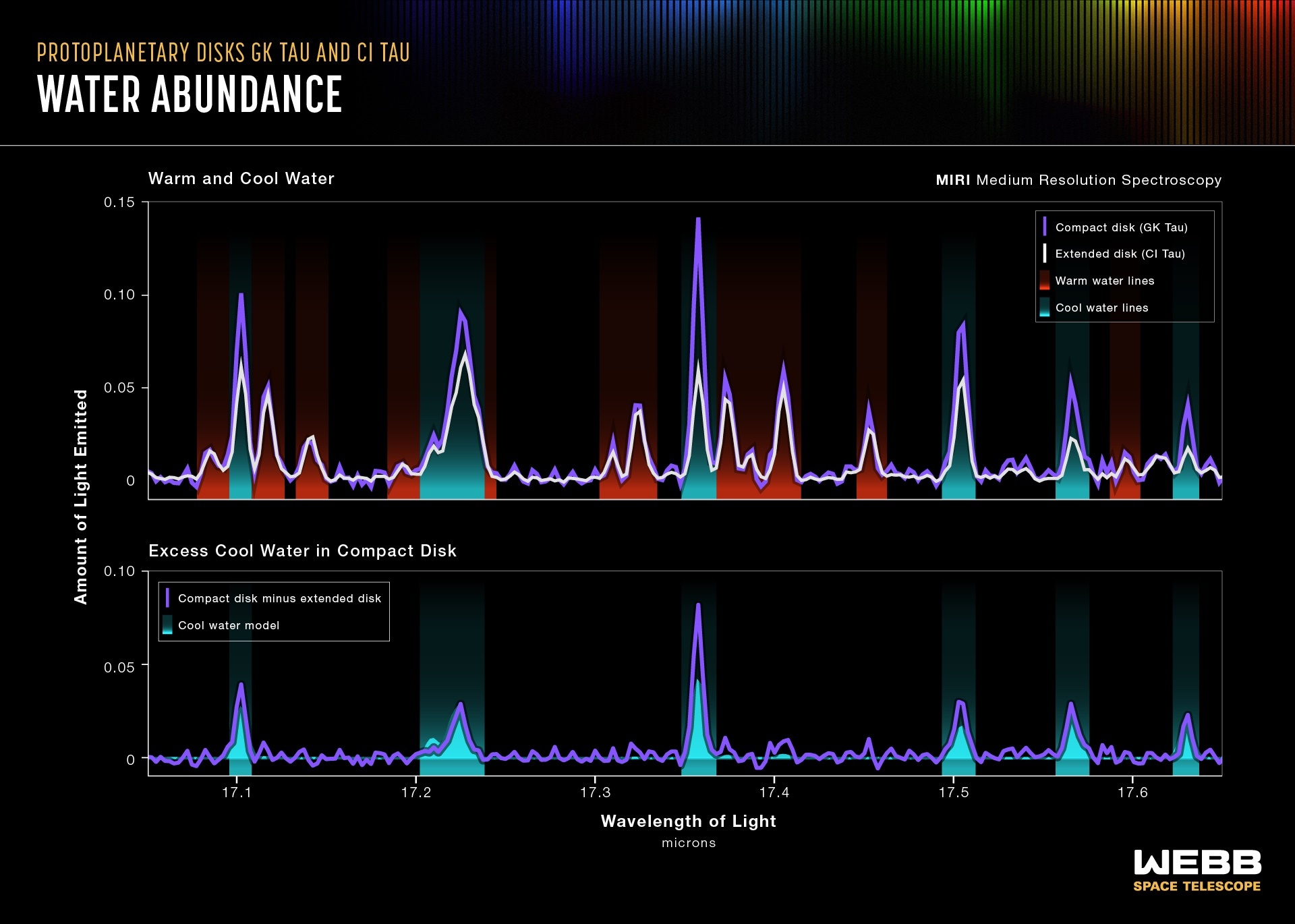
As the pebbles drift, any time they encounter a pressure bump — an increase in pressure — they tend to collect there. These pressure traps don’t necessarily shut down pebble drift, but they do impede it. This is what appears to be happening in the large disks with rings and gaps.
Current research proposes that large planets may cause rings of increased pressure, where pebbles tend to collect. This also could have been a role of Jupiter in our solar system — inhibiting pebbles and water delivery to our small, inner, and relatively water-poor rocky planets.
Solving the Riddle
When the data first came in, the results were puzzling to the research team. “For two months, we were stuck on these preliminary results that were telling us that the compact disks had colder water, and the large disks had hotter water overall,” remembered Banzatti. “This made no sense, because we had selected a sample of stars with very similar temperatures.”
Only when Banzatti overlaid the data from the compact disks onto the data from the large disks did the answer clearly emerge: the compact disks have extra cool water just inside the snowline, at about ten times closer than the orbit of Neptune.
“Now we finally see unambiguously that it is the colder water that has an excess,” said Banzatti. “This is unprecedented and entirely due to Webb’s higher resolving power!”
Image: Icy Pebble Drift
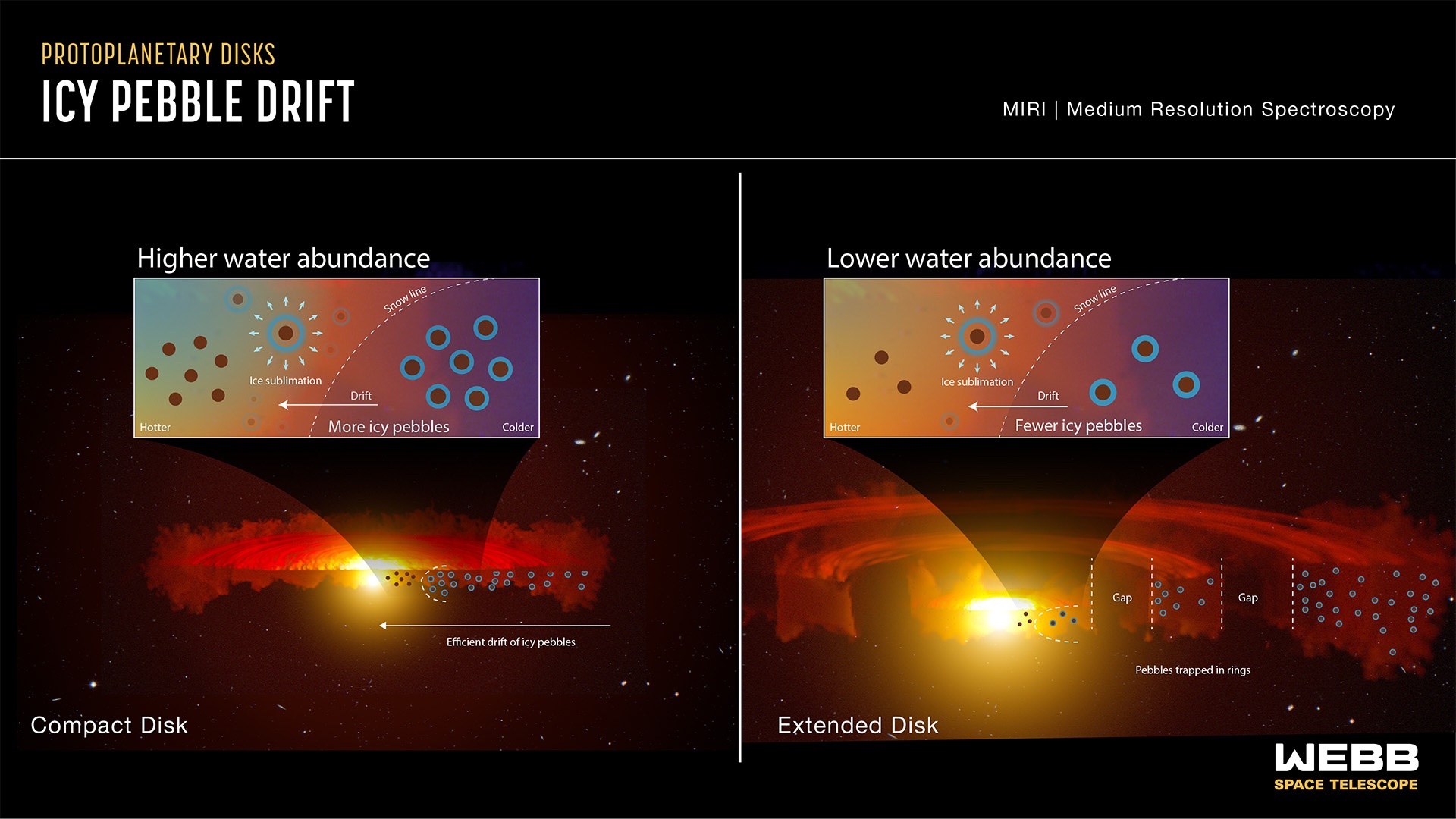
NASA’s Webb, Hubble Combine to Create Most Colorful View of Universe
NASA’s James Webb Space Telescope and Hubble Space Telescope have united to study an expansive galaxy cluster known as MACS0416. The resulting panchromatic image combines visible and infrared light to assemble one of the most comprehensive views of the universe ever taken. Located about 4.3 billion light-years from Earth, MACS0416 is a pair of colliding galaxy clusters that will eventually combine to form an even bigger cluster.
Image: Galaxy Cluster MACS0416

The image reveals a wealth of details that are only possible to capture by combining the power of both space telescopes. It includes a bounty of galaxies outside the cluster and a sprinkling of sources that vary over time, likely due to gravitational lensing – the distortion and amplification of light from distant background sources.
This cluster was the first of a set of unprecedented, super-deep views of the universe from an ambitious, collaborative Hubble program called the Frontier Fields, inaugurated in 2014. Hubble pioneered the search for some of the intrinsically faintest and youngest galaxies ever detected. Webb’s infrared view significantly bolsters this deep look by going even farther into the early universe with its infrared vision.
“We are building on Hubble’s legacy by pushing to greater distances and fainter objects,” said Rogier Windhorst of Arizona State University, principal investigator of the PEARLS program (Prime Extragalactic Areas for Reionization and Lensing Science), which took the Webb observations.
What the Colors Mean
To make the image, in general the shortest wavelengths of light were color-coded blue, the longest wavelengths red, and intermediate wavelengths green. The broad range of wavelengths, from 0.4 to 5 microns, yields a particularly vivid landscape of galaxies.
Those colors give clues to galaxy distances: The bluest galaxies are relatively nearby and often show intense star formation, as best detected by Hubble, while the redder galaxies tend to be more distant as detected by Webb. Some galaxies also appear very red because they contain copious amounts of cosmic dust that tends to absorb bluer colors of starlight.
“The whole picture doesn’t become clear until you combine Webb data with Hubble data,” said Windhorst.
Image: Side-by-side Hubble/Webb
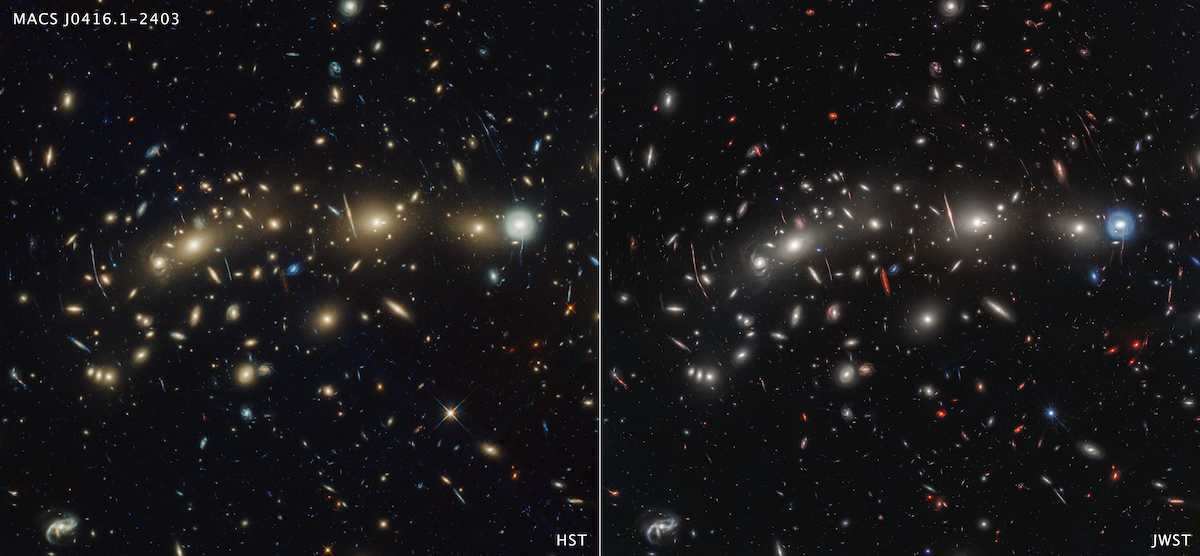
Christmas Tree Galaxy Cluster
While the new Webb observations contribute to this aesthetic view, they were taken for a specific scientific purpose. The research team combined their three epochs of observations, each taken weeks apart, with a fourth epoch from the CANUCS (CAnadian NIRISS Unbiased Cluster Survey) research team. The goal was to search for objects varying in observed brightness over time, known as transients.
They identified 14 such transients across the field of view. Twelve of those transients were located in three galaxies that are highly magnified by gravitational lensing, and are likely to be individual stars or multiple-star systems that are briefly very highly magnified. The remaining two transients are within more moderately magnified background galaxies and are likely to be supernovae.
“We’re calling MACS0416 the Christmas Tree Galaxy Cluster, both because it’s so colorful and because of these flickering lights we find within it. We can see transients everywhere,” said Haojing Yan of the University of Missouri in Columbia, lead author of one paper describing the scientific results.
Finding so many transients with observations spanning a relatively short time frame suggests that astronomers could find many additional transients in this cluster and others like it through regular monitoring with Webb.
A Kaiju Star
Among the transients the team identified, one stood out in particular. Located in a galaxy that existed about 3 billion years after the big bang, it is magnified by a factor of at least 4,000. The team nicknamed the star system “Mothra” in a nod to its “monster nature,” being both extremely bright and extremely magnified. It joins another lensed star the researchers previously identified that they nicknamed “Godzilla.” (Both Godzilla and Mothra are giant monsters known as kaiju in Japanese cinema.)
Interestingly, Mothra is also visible in the Hubble observations that were taken nine years previously. This is unusual, because a very specific alignment between the foreground galaxy cluster and the background star is needed to magnify a star so greatly. The mutual motions of the star and the cluster should have eventually eliminated that alignment.
Image: Gravitationally Lensed Galaxy
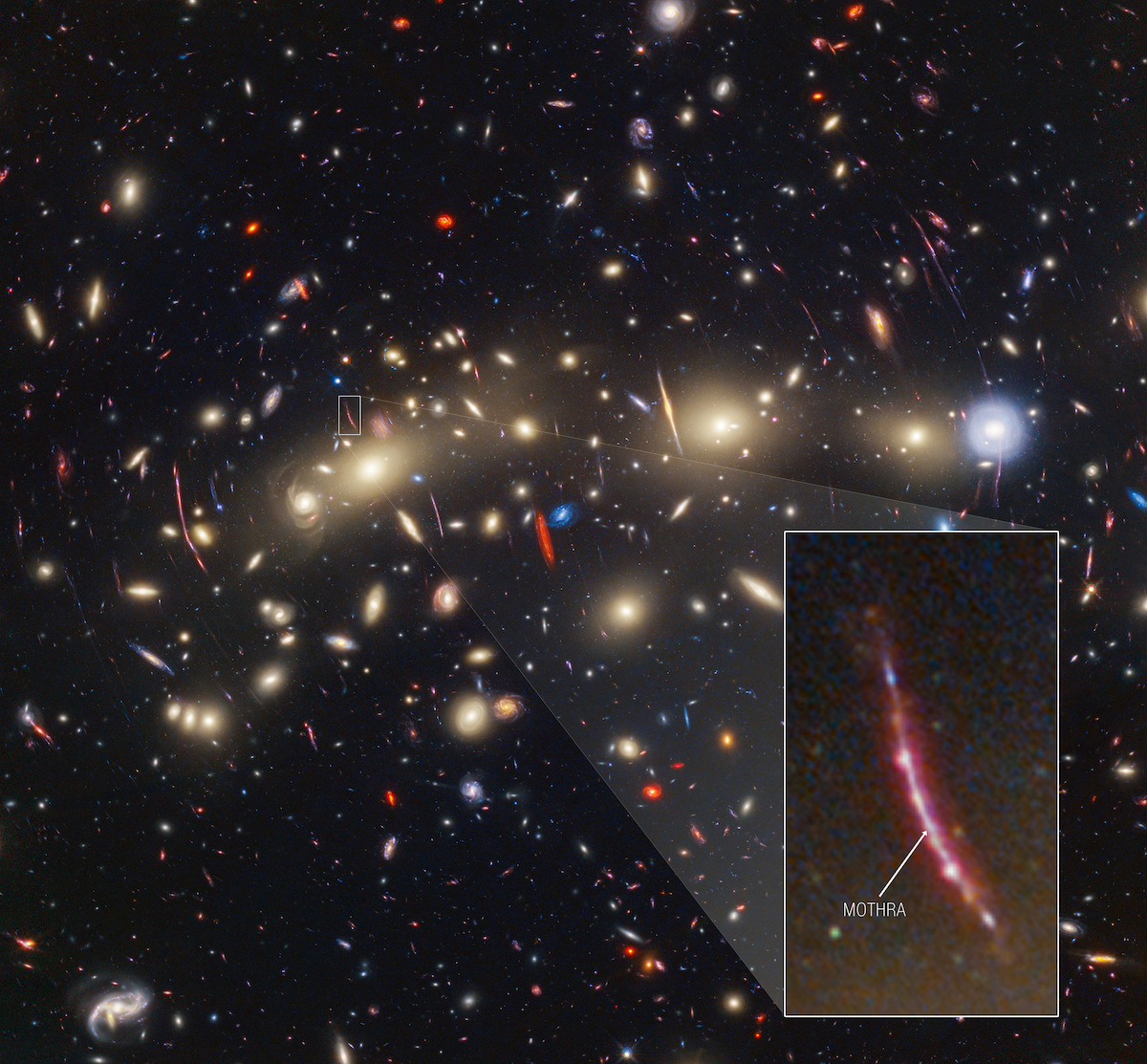
The most likely explanation is that there is an additional object within the foreground cluster that is adding more magnification. The team was able to constrain its mass to be between 10,000 and 1 million times the mass of our Sun. The exact nature of this so-called “milli-lens,” however, remains unknown.
“The most likely explanation is a globular star cluster that’s too faint for Webb to see directly,” stated Jose Diego of the Instituto de Física de Cantabria in Spain, lead author of the paper detailing the finding. “But we don’t know the true nature of this additional lens yet.”
The Yan et al. paper is accepted for publication in The Astrophysical Journal. The Diego et al. paper has been published in Astronomy & Astrophysics.
The Webb data shown here was obtained as part of PEARLS GTO program 1176.
The James Webb Space Telescope is the world’s premier space science observatory. Webb is solving mysteries in our solar system, looking beyond to distant worlds around other stars, and probing the mysterious structures and origins of our universe and our place in it. Webb is an international program led by NASA with its partners, ESA (European Space Agency) and the Canadian Space Agency.
The Hubble Space Telescope is a project of international cooperation between NASA and ESA. NASA’s Goddard Space Flight Center in Greenbelt, Maryland, manages the telescope. The Space Telescope Science Institute (STScI) in Baltimore, Maryland, conducts Hubble and Webb science operations. STScI is operated for NASA by the Association of Universities for Research in Astronomy, in Washington, D.C.
Quelle: NASA
----
Update: 15.11.2023
.
James Webb Space Telescope finds an 'extreme' glow coming from 90% of the universe's earliest galaxies
The universe's early galaxies are way brighter than they should be. The James Webb Space Telescope's discovery of brightly glowing gas around 90% of primordial galaxies may explain why.
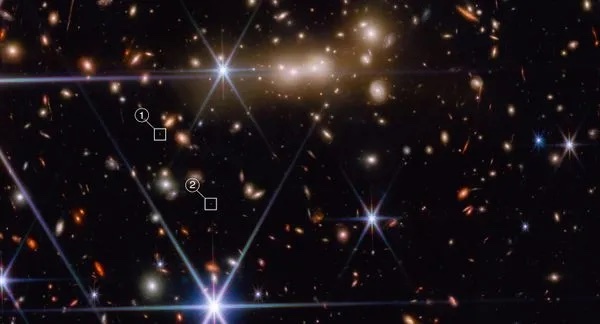
A James Webb Space Telescope image of the galaxy MACS0647-JD spotted just 400 million years after the Big Bang. (Image credit: NASA, ESA, CSA, & STScI, APagan (STScI)/ Alamy Live News via Digitaleye)
The James Webb Space Telescope (JWST) has discovered that nearly all of the universe's earliest galaxies were filled with dazzling gas clouds that blazed brighter than the emerging stars within them — and it could help solve a mystery that threatens to break cosmology.
Forming as early as 500 million years after the Big Bang, some early galaxies have been seen glowing so brightly that they shouldn't exist: Brightnesses of their magnitude should come only from massive galaxies with as many stars as the Milky Way, yet the galaxies took shape in a fraction of the time our galaxy took to form.
The discovery threatened to upend physicists' understanding of galaxy formation and even the standard model of cosmology, which states that a few million years after the Big Bang (13.8 billion years ago) energy condensed into matter from which the first stars slowly coalesced. Yet when the JWST came online, it saw far too many stars.
Now, astronomers have found a possible answer: a large group of 12 billion-year-old galaxies almost 90% of which were wreathed in bright gas that — after being ignited by light from the surrounding stars — triggered intense bursts of star formation as the gas cooled. The new research has been accepted for publication in The Astrophysical Journal.
"Our paper proves that interactions with the neighboring galaxies are responsible for the unusual brightness of early galaxies," lead author Anshu Gupta, an astrophysicist at Curtin University in Australia, told Live Science in an email. "The explosion of star formation triggered by the interactions could also explain the more massive nature of early galaxies."
Astronomers discovered the bright gas clouds in data collected as part of JWST's Advanced Deep Extragalactic Survey, which used three of the telescope's instruments to collect infrared images of galaxies before analyzing their spectra.
By peering at the frequencies of light the galaxies emitted, the researchers discovered spikes of "extreme emission features" — a clear sign that the gas was capturing light from nearby stars before reemitting it.
"Gas cannot emit light on its own," Gupta said. "But the young, massive stars emit just the right type of radiation to excite the gas — and the early galaxies have lots of young stars."
After comparing this emission spectrum with those found in newer galaxies populating today's universe, the researchers found that around 1% had similar features. The researchers said that by studying these later galaxies, which are easier to measure, they will gain important insight into the earlier galaxies and the beginnings of the universe's chemistry.
"The chemical elements that make up everything tangible on Earth and the universe, except hydrogen and helium, originated in the cores of distant stars," Gupta said. "So, it is critical to understand the conditions surrounding galaxies and stars in the early universe for us to better understand our own world today."
Quelle: SC
----
Update: 17.11.2023
.
Webb Follows Neon Signs Toward New Thinking on Planet Formation
Scientists are following neon signs in a search for clues to one planetary system’s future and the past of another – our own solar system. Following up on a peculiar reading by NASA’s previous infrared flagship observatory, the now-retired Spitzer Space Telescope, the agency’s James Webb Space Telescope detected distinct traces of the element neon in the dusty disk surrounding the young Sun-like star SZ Chamaelontis (SZ Cha).
Image: SZ Chamaeleontis Protoplanetary Disk (Artist Concept )

Differences in the neon readings between Spitzer and Webb point to a never-before-observed change in high-energy radiation that reaches the disk, which eventually causes it to evaporate, limiting the time planets have to form.
“How did we get here? It really goes back to that big question, and SZ Cha is the same type of young star, a T-Tauri star, as our Sun was 4.5 billion years ago at the dawn of the solar system,” said astronomer Catherine Espaillat of Boston University, in Massachusetts, who led both the 2008 Spitzer observations and the newly published Webb results. “The raw materials for Earth, and eventually life, were present in the disk of material that surrounded the Sun after it formed, and so studying these other young systems is as close as we can get to going back in time to see how our own story began.”
Scientists use neon as an indicator of how much, and what type, of radiation is hitting and eroding the disk around a star. When Spitzer observed SZ Cha in 2008, it saw an outlier, with neon readings unlike any other young T-Tauri disk. The difference was the detection of neon III, which is typically scarce in protoplanetary disks that are being pummeled by high-energy X-rays. This meant that the high-energy radiation in the SZ Cha disk was coming from ultraviolet (UV) light instead of X-rays. Besides being the lone oddball result in a sample of 50-60 young stellar disks, the UV vs. X-ray difference is significant for the lifetime of the disk and its potential planets.
Image: Neon Gas In Protoplanetary Disk
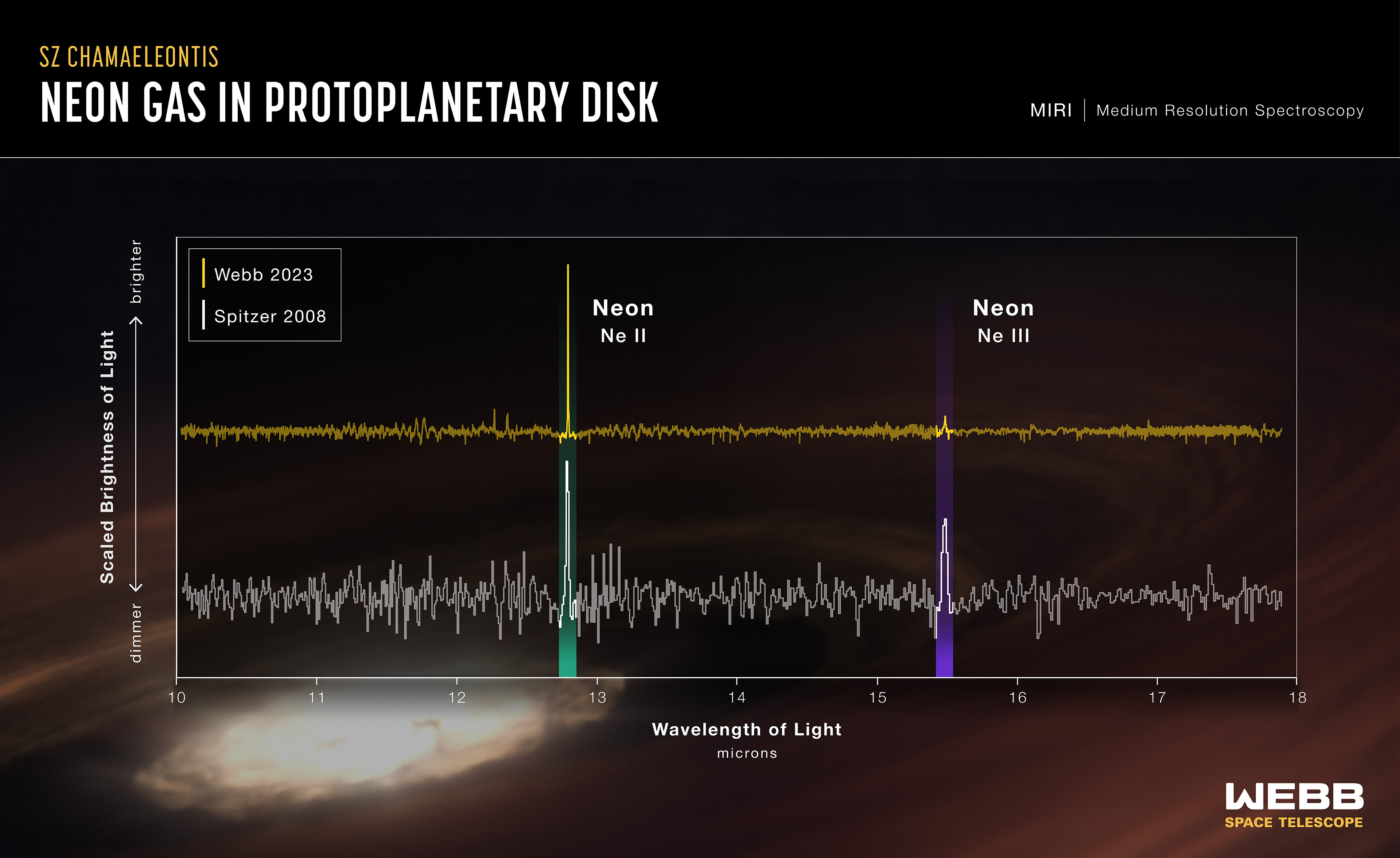
Researchers think the dramatic differences in neon detections are the result of a wind that, when present, absorbs ultraviolet light and leaves X-rays to pummel the disk. They will continue using Webb to find other examples of variability in disk conditions, working toward a better understanding of how planetary systems develop around Sun-like stars.
“Planets are essentially in a race against time to form up in the disk before it evaporates,” explained Thanawuth Thanathibodee of Boston University, another astronomer on the research team. “In computer models of developing systems, extreme ultraviolet radiation allows for 1 million more years of planet formation than if the evaporation is predominately caused by X-rays.”
So, SZ Cha was already quite the puzzle when Espaillat’s team returned to study it with Webb, only to find a new surprise: The unusual neon III signature had all but disappeared, indicating the typical dominance of X-ray radiation.
The research team thinks that the differences in neon signatures in the SZ Cha system are the result of a variable wind that, when present, absorbs UV light and leaves X-rays to pummel the disk. Winds are common in a system with a newly formed, energetic star, the team says, but it is possible to catch the system during a quiet, wind-free period, which is what Spitzer happened to do.
“Both the Spitzer and Webb data are excellent, so we knew this had to be something new we were observing in the SZ Cha system – a significant change in conditions in just 15 years,” added co-author Ardjan Sturm of Leiden University, Leiden, Netherlands.
Espaillat’s team is already planning more observations of SZ Cha with Webb, as well as other telescopes, to get to the bottom of its mysteries. “It will be important to study SZ Cha, and other young systems, in multiple wavelengths of light, like X-ray and visible light, to discover the true nature of this variability we’ve found,” said co-author Caeley Pittman of Boston University. “It’s possible that brief, quiet periods dominated by extreme UV radiation are common in many young planetary systems, but we just have not been able to catch them.”
“Once again, the universe is showing us that none of its methods are as simple as we might like to make them. We need to rethink, re-observe, and gather more information. We’ll be following the neon signs,” said Espaillat.
This research has been accepted for publication in Astrophysical Journal Letters.
Quelle:NASA
+++
WEBB TELESCOPE PEERS INTO PUFFY PLANET WITH CLOUDS OF SAND
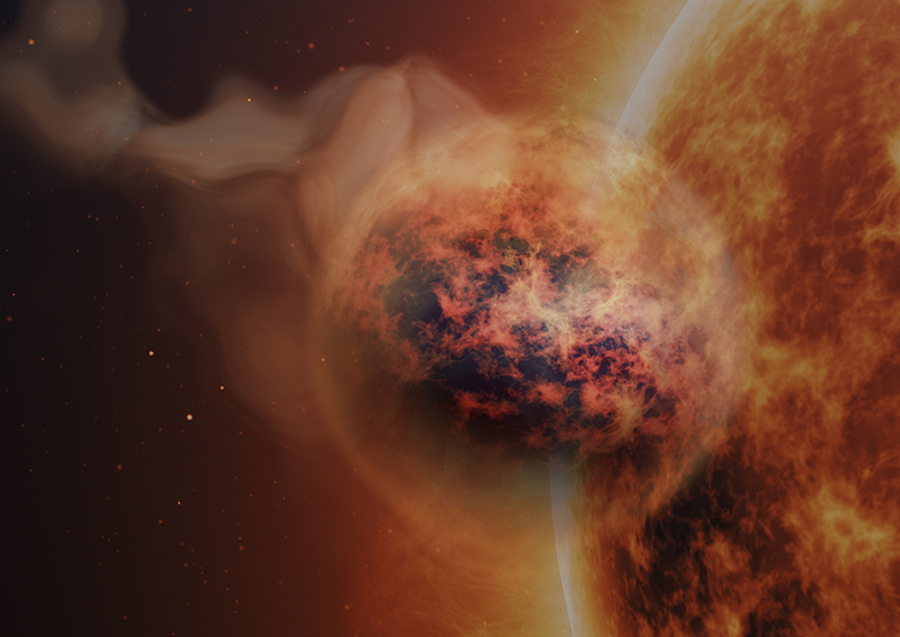
A mere 200 light-years away, there’s a planet with the density of styrofoam and clouds of sand. How did it get so weird?
It’s a strange world not even the most imaginative science fiction authors ever came up with: a planet only twice as dense as Styrofoam, enveloped in high-altitude clouds of tiny sand particles. Yet it exists, a mere 200 light-years away in the constellation Virgo.
“I like to think of this enigmatic planet as one that might defy explanation for a while,” says Sara Seager (MIT), an exoplanet researcher who was not involved in the new research.
Known as WASP-107b, the low-density planet was discovered in 2017 by the South African station of the Wide Angle Search for Planets (WASP). WASP-107b orbits its parent star once every 5.7 days at a distance of a mere 0.06 astronomical unit (six times closer to its star than Mercury is to the Sun). Earlier observations revealed the planet to be almost as large as Jupiter but only about as massive as Neptune.
Using the Hubble Space Telescope, astronomers had already detected water vapor and helium in the planet’s extended atmosphere. They also found that the atmosphere was slowly leaking awayinto space, due to irradiation from the nearby parent star.
Now, new observations with the James Webb Space Telescope (JWST) reveal additional surprises.
A STRANGE PLANET
A team led by Achrène Dyrek (University of Paris City), Michiel Min (SRON Netherlands Institute for Space Research), and Leen Decin (KU Leuven, Belgium) used JWST’s Mid-Infrared Instrument (MIRI) in January 2023 to obtain a detailed spectrum of WASP-107b during one of its frequent transits across the face of its star. The results are published in this week’s Nature.
Two surprising results had the scientists scratch their heads: MIRI revealed a much higher abundance of sulfur dioxide than predicted, while methane turned out to be completely absent.
According to Decin, the sulfur dioxide abundance could be explained by considering the extremely low density of the planet’s atmosphere. “Starlight penetrates to much deeper layers, setting off different kinds of photochemical reactions,” she says.
As for the nondetection of methane (which is abundant in the atmospheres of the giant planets in our own solar system), the researchers argue that this can only be explained by assuming that the atmospheric temperature rises very steeply with depth. While the planet’s outer layers are heated up to some 470°C (880°F), the temperature at a depth of 1,000 kilometers must reach values of up to 1,000°C — otherwise, methane molecules would surely have formed, explains Decin.
MIRI also detected evidence of “sand clouds” in the outermost atmospheric layers of WASP-107b. The tiny particles of solid silica partly obscure the spectroscopic features from further down. “This has never before been observed so clearly,” says Min.
Given the expected high wind velocities in the planet’s upper atmosphere, he speculates that a visiting spacecraft might well be sandblasted by the weird clouds.
Since microscopic sand particles are expected to “rain down” over time, some kind of atmospheric cycle must be active, remotely akin to the water cycle on Earth. The team suspects that the solid particles evaporate due to high temperatures further down. If even a shallow dip into the atmosphere brings significantly hotter temperatures (as indicated by the nondetection of methane), the silica will not have to rain too far down before it evaporates. Then vertical winds can easily bring the gaseous silica back into the upper atmosphere, where it again condenses into solid particles.
“What the authors say makes sense,” comments Seager. “Evidence for silicate particles high in the atmosphere indicate replenishing gas is brought up from deeper, hotter layers.”
Back in 2000, Seager and her colleagues already predicted the existence of clouds involving silicates, “but at that time we were not considering cycles,” she says. “Honestly, back then most astronomers did not think very many exoplanet atmospheres would ever be observed in so much detail.”
Outstanding Puzzles
According to Min, it’s still unclear why the temperature gradient in the interior of WASP-107b would be so steep, although it neatly explains the strongly inflated character of the planet. “It cannot be residual heat from the planet’s formation,” he says. “It’s too old for that. Maybe tidal effects from the parent star play a role, but no one knows for sure.”
Indeed, Yamila Miguel (Leiden Observatory, The Netherlands), who was not involved in the new research, notes that it’s “interesting to have more of these observations to better understand what drives this ‘inflation of the radius,’ which is currently unknown and debated.”
Another riddle, according to Miguel, concerns the composition of the very core of a puffed-up planet like WASP-107b. Does it consist mainly of rock, or ice? And could small amounts of hydrogen and helium be mixed in as well? “Since this is unknown for even the giant planets in our own solar system, it is definitely uncertain for exoplanets,” she says.
Meanwhile, Seager is enthusiastic about the new JWST results, and she expects much more to come. “This work is giving us a glimpse into just how diverse and complex exoplanet atmospheres actually are,” she says. “There’s so much going on in this field of research that it is very hard for anyone to keep up on all the new details.”
Quelle: Sky&Telescope
